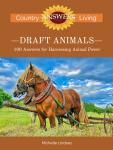
One of the largest horses in the world is the ancient Shire of Great Britain. Its precise origin is unknown. It may have had ancestors among the heavy horses of the Bretons at the time of the Roman invasions. Probably it also traces back to the Great Horse ridden by armor-clad knights of medieval times. It may be linked to the ancestors of the Belgian and the Friesian, as well.
However the Shire came about, it was prized in England for centuries, first as a war horse, and later, with the advent of gunpowder, as a draft horse. It was bred in the Midland counties (shires), such as Lincolnshire and Cambridgeshire, where soils were deep and heavy. Oxen had previously plowed these soils, since it would take a substantial horse to stand up to the work, but the mighty Shire proved that it could take on the task—and complete it far quicker than the plodding oxen could.
The dawn of the Industrial Revolution in England only increased the demand for the Shire. Livestock breeder Robert Bakewell took the Shire in hand during this time and refined it with Friesian influence, but without sacrificing its size or strength. Throughout the 1700s, and more so in the 1800s, the improved Shire was the draft horse of choice. It could farm, but it could also aid in the shipping of England. Shires hauled barges and wagons full of merchandise to and from seaports for years.
The first Shire to come to America arrived in Massachusetts before 1844, but the second importation in 1853 proved to be more influential. This was an impressive horse named John Bull, who made Illinois his new home. His strength and size convinced others to import Shires over the next few years, and by the 1880s hundreds of horses were arriving in America annually.
Although a few farmers and ranchers favored the Shire, many found grooming a large horse with feathered feet to be too onerous. A partbred Shire was typically used for farm work. The purebred Shire generally made its home in the city, where its striking looks attracted attention to whatever company it worked for.
All draft horses faced the risk of extinction after World War II, when mechanization took place. The Shire died out across most of America, persisting only among the Amish and a handful of Western farmers and ranchers.
Interest in draft horses for sustainable farming awakened a Shire revival during the 1960s and 1970s. The breed’s fortunes varied perilously over the next few decades, and it is still far from safe on our shores. However, the Shire may be represented today by as many as 1,000 animals in America, particularly in the Western and Midwestern states.
Uses

The Shire’s legendary strength comes in handy in all types of draft work. It is equally at home pulling heavy loads in the arena, the woodlot, or the field.
However, the Shire is also suitable as a saddle horse for long-legged riders. It has proven itself capable of satisfactory performance in pleasure riding, trail riding, dressage, police work, and even some basic cattle work. The Shire can also provide a genetic foundation for crossbred sport horses able to take on jumping and eventing.
Temperament
“Gentle giant” may be a cliché, but it is certainly applicable to the Shire. This horse loves people. Its sweet, mellow disposition makes it a pleasure to work with, and its desire to please makes it highly trainable.
The Shire is also famous for its calmness. Loud noises and fast movements rarely spook it. Although this trait can make it appear sluggish, the Shire does not shirk its duty—it is just one of the most stable of horse breeds.
Health

The legs and feet of the Shire are high-maintenance due to size and feathering. The hooves need regular trimming to keep them in peak health, or the weight of the horse will cause them to crack and break down. Also, the feathering must be kept clean and dry to avoid mites and fungus.
The Shire is prone to chronic progressive lymphedema, which at first may appear to be a skin infection related to the leg feathering. However, this disease is actually a partly genetic condition that affects lymph tissue and is eventually fatal.
Like many other draft horses, some Shires suffer from equine polysaccharide storage myopathy. This condition causes carbohydrates to accumulate in the muscles, leading to tremors. Fortunately, a high-fat, low-starch diet can keep an affected horse in good health.
Pros

- Easy-to-handle personality.
- Extreme strength.
- Endurance.
- Surprising athleticism.
Cons
- Relative scarcity.
- High grooming requirements.
- High maintenance costs due to large size; needs ample feed, large shoes, a roomy stall, etc.
- High impact on pastures.
- Slow working pace.
Complete Series
Helpful Resource
Draft Animals
This book from Homestead on the Range answers common questions about working with draft horses, including how to choose the right breed for you. Free sample pages are available.



